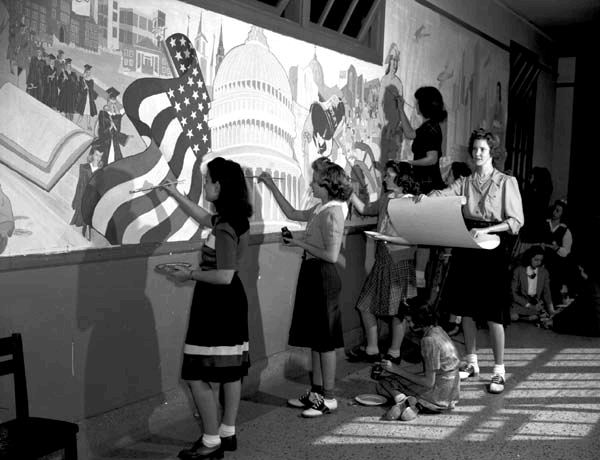|
Today in New Orleans History |
|
|
December 10


|
||
|
On December 10, 1977 Levon Helm and with the RCO Allstars and Detective performed at A Warehouse. New Orleans Born Frederick Britton Llewellyn was a noted American electrical engineer. He took a course
at the Marconi School for Wireless Operators in 1915, spent some three years in the merchant marine, and almost a year in
the Navy in 1917-1918. He then studied under Professor Alan Hazeltine at Stevens Institute of Technology, receiving his M.E.
degree in 1922. After a year as laboratory assistant to Dr. F. K. Vreeland, he joined Western Electric in 1923, transferring
in 1925 to Bell Telephone Laboratories, where he worked on the long-wave transatlantic telephone based in Rocky Point, Long
Island. From 1924-1928 he studied at Columbia University, receiving his Ph.D. in 1928. Llewellyn helped develop the
first public ship-to-shore telephone service, inaugurated in 1929 on the SS Leviathan. In the 1930s he studied noise in vacuum
tubes and constant-frequency oscillators, and researched the behavior of vacuum tubes at very high frequencies. During World
War II, he served as a consultant to the Office of Secretary of War. He and Edwin H. Armstrong designed a sensitive receiver
used to detect a radar signal reflected from the moon (Project Diana). After the war, he served as a consulting engineer,
primarily on military electronics systems, assistant to the President of Bell Telephone Laboratories 1956-1961, affiliate
of the Institute of Science and Technology at the University of Michigan 1961-1965, and research director of the Polytechnic
Institute of Brooklyn 1965 until retirement in 1967. Llewellyn was president of the Institute of Radio Engineers in
1946, and awarded the 1936 IEEE Morris N. Liebmann Memorial Award for his results on high-frequency electronics and constant-frequency
oscillators. He died on December 10, 1971. (Wiki)
Jazzman Irving Fazola was born on December 10, 1912.
The schooner Nuestra Señora del Cármen, owned by Don Prospero Ferrayolo was used as
a temporary jail during the period December 10, 1794 to February 26, 1895 after the great fire of of December
8, 1794 destroyed the royal jail along with hundreds of other buildings in the city.
Miss Alice A Leckert is named First Principal We've all passed the faded pastel pink and blue art deco building at 5712
South Claiborne Avenue and many of us have wondered why it is painted as it is. But when it first opened it was much
more colorful. As the girls stepped inside onto
inlaid terrazo floors, two cream-colored curved staircases with carved balustrades and mahogany rails could take them up the
the principals office, the main office, or the teachers room. The principals office opened to a brightly tiled, yellow-walled
court yard with a blue, green, and yellow fountain, providing a "tropical atmosphere". On
the third floor was a study hall which could accommodate 300 students. It was finished in green and buff with full-length
leaded glass doorways which led to an overhanging balcony. The classrooms were finished in green, blue,
and pink in a "modern style in perfect keeping with the personalities of the lithe creatures who will people it".
Each room had a telephone. Some large rooms could be divided by accordion doors which, when closed, provided a series of blackboards.
The building was equipped with radio and loudspeakers. Oscillating heaters were employed on the ground
floor; ventilation and heat throughout the facility were "modern to the nth degree" and there were "many and
generous windows". Natural lighting in the art room was provided by a central skylight.
There were hand dryers on each side of white wash basins. "Ducky little kitchens", each different, were designed
so that "one can learn to cook for a $15 a week clerk husband, a husband of moderate means, or a wealthy banker spouse".
The first was small with a tiny stove and diminutive sink -- "Girls will learn to manage a small apartment, so
that if they plan to live on love they will know how to feed hubby dear in cramped quarters, and on a slim income".
The second kitchen was larger, "to train for moderate housekeeping". The third had an "electric stove
and other luxuries that migh be found in a wealthy home". The auditorium"resembles a large
theater" with a saucer-shaped balcony, special switchboard for stage lighting, a projection booth "for showing both
silent and talking pictures", and an asbestos curtain side-draped with gold and blue velvet. It could accommodate 3000
people. According to the school board architect Edward C. Meric, who worked with chief architect
E.A. Christy, the "Vivid coloring is built after the fashion of such school buildings in the East and Middle West".
Schoenburger noted the "gay colors and scientific educational aids" at McMain. There were, in fact, four science
labs, 40 classrooms, a 5000 book library, and a modern cafeteria in the building which measured 180 x 390 feet and was built
at a cost of $550,000. This "colorful structure embodying many new ideas in education was opened under the direction
of Miss Alice A Leckert, principal. E.A. Christy submitted building plans for school on August 13, 1930. McMain was scheduled to open
on the same day that the new boys school, Alcee Fortier was to open, in February 1931.. The building permit for McMain was
approved by city engineers on October 29, 1930. J. A. Petty was the builder of the school located on South Claiborne between
Joseph and Nashville streets. Construction work started in November. On December 10, 1930, Miss Leckert, principal of
McDonough No. 14, was named as McMain's first principal. Fortier opened as planned on February 2, 1931
but McMain did not. As Fortier welcomed as many as 1500 boys, McMain's first floor had yet to be completed. According
to Christy, difficulties were encountered in the foundation and excavation because "the site was once a swamp".
The builder expected to sink 45 foot pilings but instead was forced to use 70 foot piles. To further the delay, many
tree stumps had to be removed from the boggy location. Girls who were scheduled to attend McMain, whose student boundaries
were South Carrollton, St. Charles Avenue, Howard Avenue, and Loyola University, enrolled instead at Sophie B. Wright.
The opening of McMain was rescheduled for the fall of 1931. Plaster-work for McMain was executed by
Sam C. Ball and Company, whose work could also be seen in five public markets and the old U.S. Mint. In July, $13, 730.36
was approved for purchasing furniture and equipment. On September 6, 1931 registration was open for McMain students
but their school was still not ready. Nicholas Bauer, Orleans Parish Superintendent of Education announced that it would
open on September 31. But on September 12, officials announced that the school would not be opened until February of
1932. In January,, Fortier boys held their graduation exercises in McMain's auditorium but liens
against the McMain contractor threatened to delay the girls school's February opening. After legal wrangling, McMain finally
opened its doors to the public on Sunday, January 31, 1932 from 4 to 7 p.m. when a reception was hosted by the teachers.
The 917 students' first day was Monday, February 1, when the girls gathered in the auditorium for speeches by local dignitaries
followed by a flag raising ceremony with music provided by the Warren Easton band. This New Orleans
Public Library photo shows McMain students on November 17, 1941 painting a mural in the corridor of their school. They are
Christeen Young, Gayle Hughes, Mary McGowan, Lois Townley (on ladder), Sybil Jung (seated), and Jane Menz. Today
Eleanor McMain Secondary School is open to boys and girls in the 7th through 12th grades. Still under the direction
of the Orleans Public Schools, it has 769 students whose graduation rate is 95%. Mary Leta Dorothy Slaton is Born
in New Orleans December 10, 1914 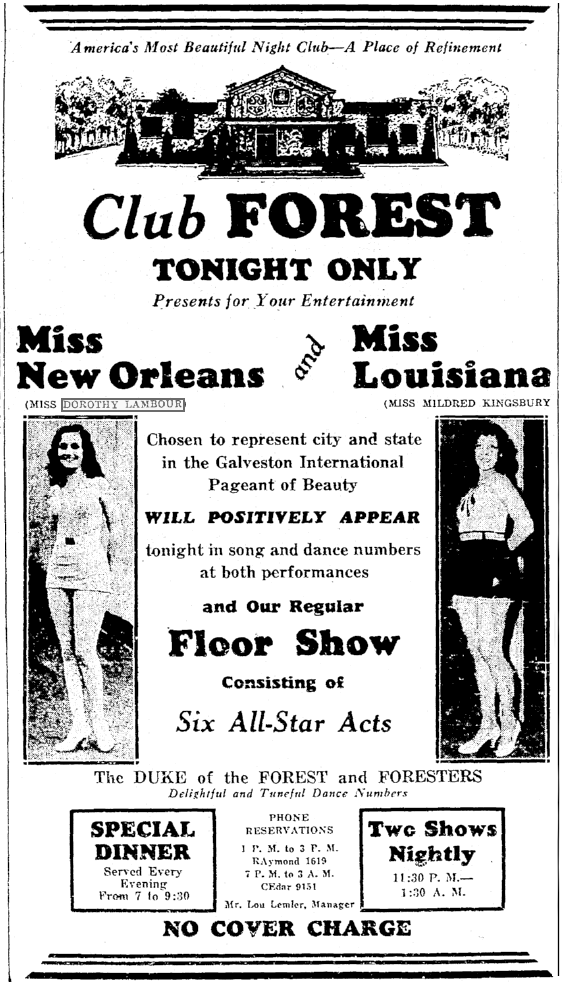 Born in the charity ward of Touro Infirmary ("We were not well off", she said) on December 10, 1914 (some sources
dispute this date), Mary Leta Dorothy Slaton grew up to be a movie star. She attended Beauregard elementary school,
where from she remembered playin hooky to go to Canal Street to pay 15 cents to spend the day watching the same movie over
and over again. She was hooked. Born in the charity ward of Touro Infirmary ("We were not well off", she said) on December 10, 1914 (some sources
dispute this date), Mary Leta Dorothy Slaton grew up to be a movie star. She attended Beauregard elementary school,
where from she remembered playin hooky to go to Canal Street to pay 15 cents to spend the day watching the same movie over
and over again. She was hooked.The daughter of John Watson
Slaton and Carmen Louis LaPorte, she was also raised by her cousin Jeanne Deshotels and her mother Jeanne Schwerz. After
divorcing Slaton, Carmen married Clarence Lambour and Dorothy took his last name. Deshotel remembered taking the young
"Dottie" to St. Louis Cathedral whereupon the child sang the 1918 jazz hit "Ja-Da (Ja Da, Ja Da, Jing, Jing,
Jing!) when the organ began playing. "I was so embarrassed", she said, "I couldn't shut her up". As a teenager, she began entering beauty contests. In 1929 Dottie took first-place
in a Biloxi pageant and earned the title Miss American Legion of New Orleans. On July 26, 1930 she was a contestant,
along with her friend Dorothy Dell Goff, in the Miss New Orleans beauty contest at Pontchartrain Beach's original location
at Bayou St. John and the lakefront. Goff was crowned queen, and Dottie took fourth place, in front of a crowd reportedly
of 10,000 people. A few weeks later, on Friday, August
1, 1930, Dottie and Dorothy boarded a 9 p.m. train at Union Station along with their mothers to head to Galveston for the
International Pageant of Pulchritude (the Miss America and Miss Universe contests). Dottie's ranking in the New Orleans
pageant qualified her as an alternate for Goff, who was crowned Miss United States (Miss America) on August 5, 1930 and then
Miss Universe on August 10, 1930 in the Texas pageants. Goff, as Dorothy Dell became a film actress whose young life
was cut short in an automobile accident on June 8, 1934 near Pasadena, California. Dottie Lambour won the 1931 Miss New Orleans contest wearing a blue bathing suit and a blue linen dress she
had bought on Canal Street for $2.98. Miss Lambour is seen here in an advertisement for
Club Forest (407 Jefferson Highway) on June 7, 1931. She did, in fact, go on to the 1931 Galveston pageant but failed
to take a crown. She attended Spencer Business College and took a job in the real real estate business but still dreamed
of fame. According a 1974 interview with local writer David Cuthbert, Dottie bought two tickets to Chicago, left one
along with a note to her mother, and left New Orleans for a bigger city. Her mother arrived the following day.
They took jobs in a restaurant, with Carmen in the kitchen and Dottie waiting tables. She said the trays were too heavy
for her to carry so "I walked into Marshall Field Department Store. I had a terrible inferiority complex but when
you do you put up more of a front." "I want to see the supervisor" she said, to which the response was
"Which one?" "Well that stopped me. At D.H. Holmes and Maison Blanche all they had was one. In
those days at Marshall Field they had nine. All I could get out was 'I want to ride an elevator'. She got the job.While performing
at a night clubs she was "discovered" by orchestra leader Herbie Kay who hired her to sing for his band. On November 14, 1932 she was back in New Orleans and back at Club Forest
performing with Kay's "nation-wide famous band" featuring Dorothy Lambour (Miss New Orleans 1931)". She
later said that a Dallas sign painter left the "B" out in her name on a hotel display announcing the band's performances
and that Herbie Kay adivised her to let it be, and so she became "Dorothy Lamour". She also became Mrs. Herbie
Kay/Mrs. Herbert F. Kaumeyer on Monday, May 13, 1935. "Without Herbie, I don't think I'd be in show business", she
said. 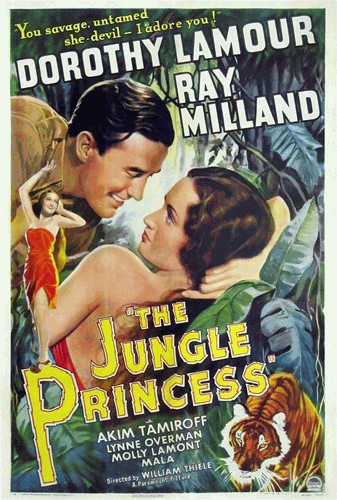 A November 23, 1936 article mentioned that Dorothy Lamour "once of New Orleans, is seen in a short feature on the Saenger
bill" which was likely a short film adopted from her New York radio show "Dreamer of Songs". Local entertainment
writer Charles P. Jones, in a January 17, 1937 article, briefly reviewed "Jungle Princess" (starring Lamour and
Ray Milland) which was playing at the Tudor Theater. "Miss Lamour is given a chance to sing as well as act, and
the picture is certain to make its heroine and impressive movie figure", he wrote. And so it was. Not to
mention that Dottie's "impressive figure" was wrapped in a sarong which made her as famous as she made it. A November 23, 1936 article mentioned that Dorothy Lamour "once of New Orleans, is seen in a short feature on the Saenger
bill" which was likely a short film adopted from her New York radio show "Dreamer of Songs". Local entertainment
writer Charles P. Jones, in a January 17, 1937 article, briefly reviewed "Jungle Princess" (starring Lamour and
Ray Milland) which was playing at the Tudor Theater. "Miss Lamour is given a chance to sing as well as act, and
the picture is certain to make its heroine and impressive movie figure", he wrote. And so it was. Not to
mention that Dottie's "impressive figure" was wrapped in a sarong which made her as famous as she made it.Costume designer Edith Head admitted that her sarong was "born"
for "Jungle Princess". "It wasn't even authentic", she said. A real sarong wrapped the body
only below the waist but that "wouldn't clear any censor". Head also described the process of selecting the
sarong wearer for "Jungle Princess"; a nation-wide search by the studio brought in state winners for screen tests;
each young woman wore the same sarong, same bracelet, and same blossom behind their ears; the wolf-whistle originated during
Lamour's screen test as stage-hands watched and the wolf-whistle became a "system" at the studio whereby a certain
number of whistles predicted a young actress' probable popularity with the general public. The sarong and Lamour teamed with Hope and Crosby and went "on the road" to Singapore (1940), Zanzibar
(1941), Morocco (1942), Utopia (1946), Rio (1947), to Bali (1952), and Hong Kong (1962). Dottie came home to celebrate
her 50th birthday on December 10, 1967 while on a tour starring in "Hello, Dolly!" which ran at the Municipal Auditorium
on Saturday, December 16. Back home again to perform in "Fallen Angels" at the Beverly Dinner Playhouse on
February 22, 1974 she said to David Cuthbert of the Times-Picayune "Honey, those studios biographers didn't care what
they said about you. They had me born in Chicago, New York, got may age wrong -- I don't care what the World Almanac
or the film books say, I am 56, NOT 59!" Dottie made a total
of 50 flims, seven of them in the "Road to..." series. During World War II she performed for GIs, hosted at
USO facilities, was one of the most popular pin-up girls, and was not only the first star to volunteer to sell war bonds but
is also credited with selling some $300 million worth of them. In later years she toured with theatrical shows
and became more active in volunteer service. Referring to the 1987 film ''Creepshow 2,'' where she played sloppily housewife
who is murdered, she said ''Well, at my age you can't lean against a palm tree and sing 'Moon of Monakoora.'' Dottie died
on September 22, 1996 in North Hollywood at the age of 81.
|
|
|
|

To receive an update for each day in New Orleans history,
join our facebook page - Today in New
Orleans History.
Analytics |
||

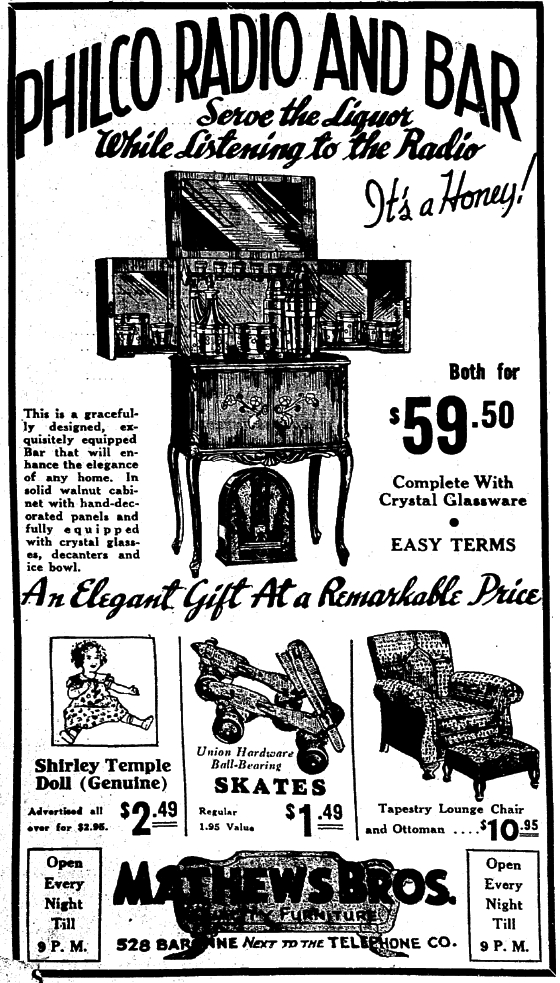

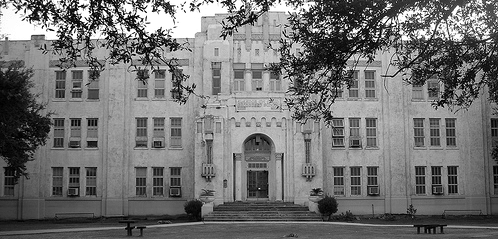 Eleanor McMain High for Girls first welcomed ----- on February 1, 1932. It was the only New Orleans public school named
for a living person, but an exception had been made to honor Miss McMain who had done so much for so many through her work
at Kingsley House in the Irish Channel. Under McMain's guidance and leadership, Kingsley House had grown from a modest
parish outreach program at 929 Tchoupitoulas of the Trinity Episcopal Church parish to an internationally known settlement
house. Elanor McMain must have been bowled over by what Times-Picayun writer Podine Schoenburger described as the "new
high school which combines luxury with efficiency" in a symphony of riotous, splashing color".
Eleanor McMain High for Girls first welcomed ----- on February 1, 1932. It was the only New Orleans public school named
for a living person, but an exception had been made to honor Miss McMain who had done so much for so many through her work
at Kingsley House in the Irish Channel. Under McMain's guidance and leadership, Kingsley House had grown from a modest
parish outreach program at 929 Tchoupitoulas of the Trinity Episcopal Church parish to an internationally known settlement
house. Elanor McMain must have been bowled over by what Times-Picayun writer Podine Schoenburger described as the "new
high school which combines luxury with efficiency" in a symphony of riotous, splashing color".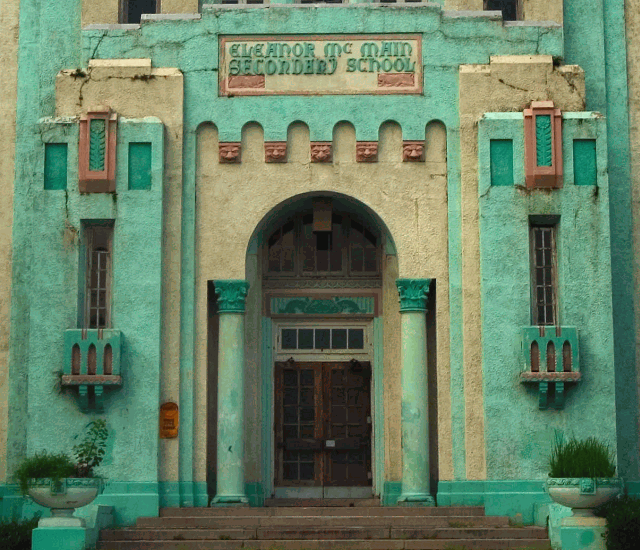 The photos here are new. The following descriptions are from Podine Schoenburger's January 10, 1932 article. The colors
described by Shoenburg don't match the modern-day colors but give us aglimpse or what the building looked like so many
years ago: The exterior of the stucco school building was painted green. Schoenburger described the "strange colorful
entrance" with vivid blue urns, one at each side of the main door, in which century plants were growing. The carved tops
of the white pillars flanking the doorway were painted green and cold. The doors were of leaded glass with a basket
of brightly colored flowers topping them. Green grinning gargoyles topped them all, and above them the nameplate was blue
with with gold letters spelling out the school's name amid a pair of gold lions.
The photos here are new. The following descriptions are from Podine Schoenburger's January 10, 1932 article. The colors
described by Shoenburg don't match the modern-day colors but give us aglimpse or what the building looked like so many
years ago: The exterior of the stucco school building was painted green. Schoenburger described the "strange colorful
entrance" with vivid blue urns, one at each side of the main door, in which century plants were growing. The carved tops
of the white pillars flanking the doorway were painted green and cold. The doors were of leaded glass with a basket
of brightly colored flowers topping them. Green grinning gargoyles topped them all, and above them the nameplate was blue
with with gold letters spelling out the school's name amid a pair of gold lions. 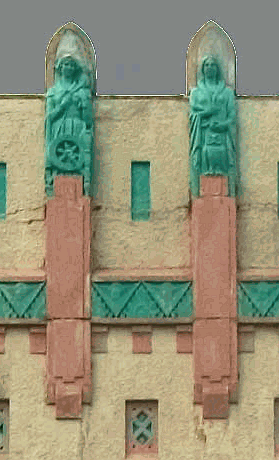 High above the entrance of the three-story building are two sculptures by Albert Ricker. The first depicted a
young Acadian maiden in a blue dress, starched apron, and a spinning wheel at here feet to symbolize industry. The second
figure is of an older woman, with an owl as symbol of wisdom.
High above the entrance of the three-story building are two sculptures by Albert Ricker. The first depicted a
young Acadian maiden in a blue dress, starched apron, and a spinning wheel at here feet to symbolize industry. The second
figure is of an older woman, with an owl as symbol of wisdom. 